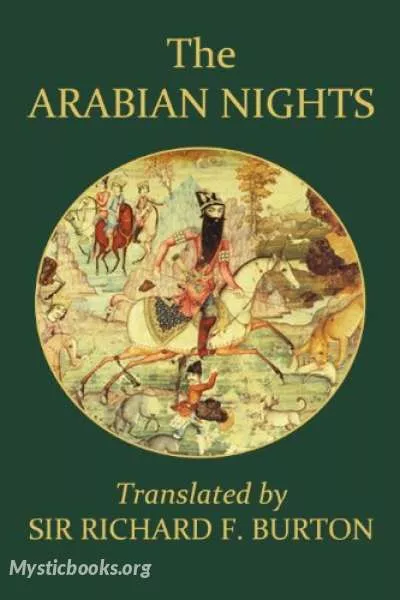
The Book of A Thousand Nights and a Night (Arabian Nights), Volume 01
'The Book of A Thousand Nights and a Night (Arabian Nights), Volume 01' Summary
The main frame story concerns Shahryār (Persian: شهريار, from Middle Persian: šahr-dār, 'holder of realm'), whom the narrator calls a "Sasanian king" ruling in "India and China." Shahryār is shocked to learn that his brother's wife is unfaithful. Discovering that his own wife's infidelity has been even more flagrant, he has her killed. In his bitterness and grief, he decides that all women are the same. Shahryār begins to marry a succession of virgins only to execute each one the next morning, before she has a chance to dishonour him.
Eventually the Vizier (Wazir), whose duty it is to provide them, cannot find any more virgins. Scheherazade (Persian: شهْرزاد, Shahrazād, from Middle Persian: شهر, čehr, 'lineage' + ازاد, āzād, 'noble'), the vizier's daughter, offers herself as the next bride and her father reluctantly agrees. On the night of their marriage, Scheherazade begins to tell the king a tale, but does not end it. The king, curious about how the story ends, is thus forced to postpone her execution in order to hear the conclusion. The next night, as soon as she finishes the tale, she begins another one, and the king, eager to hear the conclusion of that tale as well, postpones her execution once again. This goes on for one thousand and one nights, hence the name.
The tales vary widely: they include historical tales, love stories, tragedies, comedies, poems, burlesques, and various forms of erotica. Numerous stories depict jinn, ghouls, apes, sorcerers, magicians, and legendary places, which are often intermingled with real people and geography, not always rationally. Common protagonists include the historical Abbasid caliph Harun al-Rashid, his Grand Vizier, Jafar al-Barmaki, and the famous poet Abu Nuwas, despite the fact that these figures lived some 200 years after the fall of the Sassanid Empire, in which the frame tale of Scheherazade is set. Sometimes a character in Scheherazade's tale will begin telling other characters a story of his own, and that story may have another one told within it, resulting in a richly layered narrative texture.
Different versions differ, at least in detail, as to final endings (in some Scheherazade asks for a pardon, in some the king sees their children and decides not to execute his wife, in some other things happen that make the king distracted) but they all end with the king giving his wife a pardon and sparing her life.
The narrator's standards for what constitutes a cliffhanger seem broader than in modern literature. While in many cases a story is cut off with the hero in danger of losing their life or another kind of deep trouble, in some parts of the full text Scheherazade stops her narration in the middle of an exposition of abstract philosophical principles or complex points of Islamic philosophy, and in one case during a detailed description of human anatomy according to Galen—and in all of these cases she turns out to be justified in her belief that the king's curiosity about the sequel would buy her another day of life.
Book Details
Language
EnglishOriginal Language
Arabic, PersianPublished In
Authors

Richard Francis Burton
England
Sir Richard Francis Burton was a British explorer, scholar and soldier. He was famed for his travels and explorations in Asia, Africa, and the Americas, as well as his extraordinary knowledge of langu...
Books by Richard Francis BurtonDownload eBooks
Listen/Download Audiobook
- Select Speed
Related books

St. George and St. Michael, Volume 1 by George MacDonald
In the quaint village of Marshmallows, where folklore and reality intertwine, a long-standing feud between two families shrouds the land in enigmatic...

Granny's Wonderful Chair by Frances Browne
This is the story of Snowflower. Left to fend for herself by her grandmother, Dame Frostyface, Snowflower turns to the ‘wonderful chair’ for company....

Fearsome Creatures of the Lumberwoods by William T. Cox
Fearsome Creatures of the Lumberwoods, With a Few Desert and Mountain Beasts is a 1910 fantasy field guide by William Thomas Cox (1878–1961), Minnesot...

Popular Tales from the Norse by Sir George Webbe Dasent
The most careless reader can hardly fail to see that many of the Tales in this volume have the same groundwork as those with which he has been familia...

Dutch Twins by Lucy Fitch Perkins
The Dutch Twins is a charming children's novel that follows the adventures of two young siblings, Katrinka and Peter, as they navigate the everyday li...

Chinesische Volksmärchen by Richard Wilhelm
This collection of Chinese folk tales presents a diverse selection of stories that reflect the cultural and spiritual traditions of China. From whimsi...

Old Greek Stories by James Baldwin
A retelling of old Greek stories involving mythological heroes and their adventures. Tales include those of Prometheus, Io, Perseus and Theseus.

versiegelte Engel by Nikolai Leskov
In einer kalten Winternacht in einer überfüllten russischen Herberge berichtet ein Gast von der Beschlagnahme aller Heiligenbilder seiner altgläubigen...

The Key of Gold: 23 Czech Folk Tales by Joseph Baudis
This collection is a mixture of morals, quirkiness, and sarcasm. In it one finds ironic derivatives (if not roots) of well known fairy tales such as “...

Story of Sir Launcelot and His Companions by Howard Pyle
This book is a collection of stories about Sir Launcelot and his companions, knights of King Arthur's Round Table. The stories are retold for young re...
Reviews for The Book of A Thousand Nights and a Night (Arabian Nights), Volume 01
No reviews posted or approved, yet...